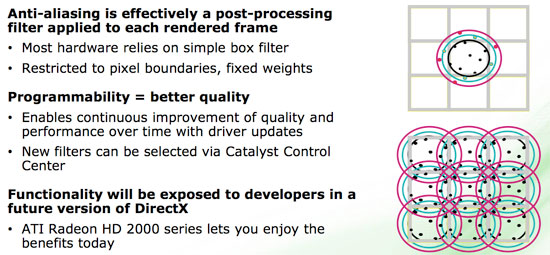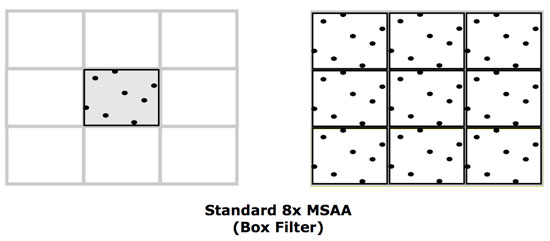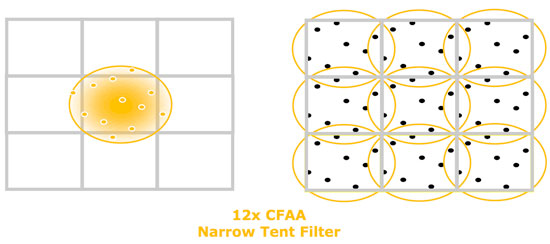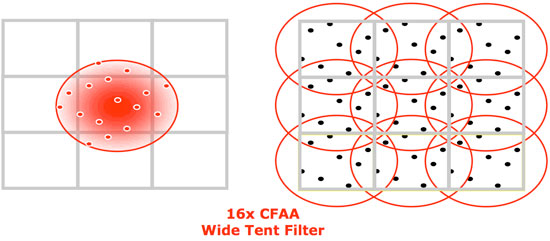ATI Radeon HD 2900 XT: Calling a Spade a Spade
by Derek Wilson on May 14, 2007 12:04 PM EST- Posted in
- GPUs
CFAA and No Fixed Resolve Hardware
That's right, R600 doesn't have hardware dedicated to resolving MSAA in the render back end - the only MSAA related tasks handled in the render back end are compression and evaluation of the subpixels. All antialiasing resolve is performed on the shader hardware. Certainly, AMD would prefer we start by telling you about the neat custom resolve filters that can be implemented on their shader hardware, but we would rather speculate about this for a moment first.
AMD has stated that, moving forward, in addition to allowing programmable sample patterns, future DX versions may allow for custom resolve filters as well. This is cited as one of the reasons why R600 uses shader hardware to resolve AA samples. AMD has given us a couple different resolve filters to play with, which we'll talk about in a minute. But at a point where we're seeing the first DX10 hardware from graphics makers, and at a time where competitive performance is paramount, it doesn't seem like the decision we would have made.
Whatever the circumstances, R600 sends its pixels back up from the render back ends to the shader hardware to combine subpixel data into a final pixel color. In addition to the traditional "box" filter (which uses subpixels within the area of a single pixel), the new driver offers the ability to use subpixel data from neighboring pixels resolved with a tent filter (where the impact of the subpixels on final color is weighted by distance). AMD calls this CFAA for custom filter antialiasing.

AMD currently offers narrow and wide tent filters which can be implemented using 2, 4, or 8 multisamples per pixel boundary. This gives us nine different AA options including traditional box filters. More filter options can be provided via driver updates, as these are essentially driver managed shader programs. Here's the breakdown of the options based on the type of filter and the number of samples used to resolve each pixel.



One of the useful side effects of these tent filters is that they are also capable of antialiasing interior pixels, not just those covered by more than one triangle. This is helpful in getting rid of aliasing in textures which can occur in certain cases.
While tent filters are a very interesting idea to improve antialiasing, they are not without their drawbacks. First, it is possible for tent filters, even though neighboring subpixel data is weighted less than internal subpixels, to create a muddy look, especially with high contrast fine detail like thin text for example. While tent filters can antialias textures on interior pixels, they can also create a blur effect where it isn't needed which removes detail from the scene.
Edge Detection
While tent filters are good in the general edge case, in order to be really compelling from an image quality stand point, AMD decided to go a step further and adaptively apply more AA in places where it would do the most good and less elsewhere. This will be done by applying an edge detect algorithm to the framebuffer and using more aggressive AA on these edges.
We learned that edge detection can be sped up by looking at pixel compression. If all the subpixels for one fragment are the same color, compression will be at its highest and there is no edge within that pixel. Beyond using this information, we are told that the algorithm uses straightforward derivative computations to find high frequency data (high contrast edges) much the same way Photoshop does.
The combination of edge detection and tent filters gives us two extra option beyond the ones listed above: 12x narrow tent filter with edge detect and 24x wide tent filter with edge detect. These filters are capable of very good image quality, though this quality does come at a performance cost. We will take a look at performance and image quality after we finish going through R600 hardware.










86 Comments
View All Comments
dragonsqrrl - Thursday, August 25, 2011 - link
You forgot c).-if you're an ATI fanboy
vijay333 - Monday, May 14, 2007 - link
http://www.randomhouse.com/wotd/index.pperl?date=1...">http://www.randomhouse.com/wotd/index.pperl?date=1..."the expression to call a spade a spade is thousands of years old and etymologically has nothing whatsoever to do with any racial sentiment."
strikeback03 - Wednesday, May 16, 2007 - link
What about in Euchre, where a spade can be a club (and vice versa)?johnsonx - Monday, May 14, 2007 - link
Just wait until AT refers to AMD's marketing budget as 'niggardly'...bldckstark - Monday, May 14, 2007 - link
What do shovels have to do with race?Stan11003 - Monday, May 14, 2007 - link
My big hope out all of this that the ATI part forces the Nvidia parts lower so I can use my upgrade option from EVGA to get a nice 8800 GTX instead of my 8800 GTS ACS3 320. However with a quad core and a decent 2GB I have no gaming issues at all. I play at 1600x1200(when that become a low rez?) and everything is butter smooth. Without newer titles all this hardware is a waist anyways.Gul Westfale - Monday, May 14, 2007 - link
the article says that the part is not a failure, but i disagree. i switched from a radeon 1950pro to an nvidia geforce 8800GTS 320MB about a mont ago, and i paid only $350US for it. now i see that it still outperforms the new 2900...one of my friends wanted to wait to buy a new card, he said he hoped that the ATI part was going to be faster. now he says he will just buy the 8800GTS 320, since ATI have failed.
if they can bring out a part that competes well with the 8800GTS and price it similarly or lower then it would be worth buying, but until then i will stick with nvidia. better performance, better price, and better drivers... why would anyone buy the ATI card now?
ncage - Monday, May 14, 2007 - link
My conclusion is to wait. All of the recent GPU do great with dx9...the question is how will they do with dx10? I think its best to wait for dx10 titles to come out. I think crysis would be a PERFECT test.wingless - Monday, May 14, 2007 - link
I agree with you. Crysis is going to be the benchmark for these DX10 cards. Its hard to tell both Nvidia and AMD's DX10 performance with these current, first generation DX10 titles (most of which have a DX9 version) because they don't fully take advantage of all the power on both the G80 or R600 yet. Its true that Crysis will have a DX9 version as well but the developer stated there are some big differences in code. I'm an Nvidia fanboy but I'm disappointed with the Pure Video and HDMI support on the 8800 series cards. ATI got this worked out with their great AVIVO and their nice HDMI implementation but for now Nvidia is still the performance champ with "simpler" hardware. The G80 and R600 continue the traditions of their manufacturers. Nvidia has always been about raw power and all out speed with few bells and whistles. ATI is all about refinement, bells and whistles, innovations, and unproven new methods which may make or break them.All I really want to wait for is to see how developers embrace CUDA or ATI's setup for PHYSICS PROCESSING! Both companies seem to have well thought out methods to do physics and I cant wait to see that showdown. AGEIA and HAVOK need to hop on-board and get some software support for all this good hardware potential they have to play with. Physics is the next big gimmick and you know how much we all love gimmicks (just like good 'ole 3D acceleration 10 years ago).
poohbear - Monday, May 14, 2007 - link
they dont make a profit from high end parts that's why they're not bothering w/ it? that's AMD's story? so why bother having an FX line w/ their cpus?